Kutch – If this word reminds you of only the White Desert then be ready to see the colourful side of the Kutch through the journey of the Crafts of Kutch. Kutch area in Gujarat in India is extremely rich in unique crafts and approximately 20 different types of crafts are practised in Kutch which are extremely unique in the region. Few crafts of Kutch you will find only one family or a maximum of two families who are practising in the entire world. If you are planning to Kutch region to Rann of Kutch or Rann Utsav then exploring the nearby villages of Kutch in Gujarat is an absolute must to explore the crafts of Kutch.
The crafts of the Kutch region will help you to understand the rich culture and history of the place and will give you a sneak peek at the way of living. The area of Kutch will show you the side of Vibrant Gujarat. I got to explore the region of Kutch on my trip with the Ministry of Tourism and Gujarat Tourism.
Before we get into the details of the crafts of the Kutch area, let us understand why the area of Kutch is so rich in various unique crafts.
History of Kutch Region?
At one point in time, the region of Kutch was an important area for settlements with the oldest settlements found up to Indus Valley civilizations. We can find the mention of Kutch in various writings from the era of Alexander.
The area of Kutch has been ruled by Greeks from the Greco-Bactrian Kingdom to Rajputs to Singh Tribes. The area of Kutch has not only seen the influences of various kingdoms but many nomadic tribes also made the area of Kutch it's home.
The designs & crafts of Kutch draws a clear influence of these cultures and lifestyle of the nomadic tribes. We will go ahead and dissect how each craft of the Kutch region draws influence from various cultures and how the craft came to Kutch.
There are approximately 20 crafts of the Kutch region however in this blog post we will discuss 6 crafts of Kutch which defines the region of Kutch through its uniqueness.
Rogan Art of Kutch
Let us start the journey of Crafts in the Kutch region through a very unique form of painting called Rogan Art. There is only a single family of 8 members in the entire world that practices this art of Rogan Painting.
The Rogan art of Kutch was almost vanishing and we were losing a heritage, however, thanks to the family of Abdul Gafar Khatri & government of India and the Tourism department the Rogan art of Kutch is not only surviving but also flourishing now.
Rogan art came from Persia and came to India around 400 years ago. Rogan means Oil Based painting in Persia. The Rogan is prepared by boiling castor oil for 1-2 days. The Rogan looks like sticky chewing gum and feels rubbery.
To add the colours in Rogan, mineral colours or natural colours are added to the Rogan. So that the Rogan doesn’t dry up, the coloured Rogans are placed in water which keeps it moist and ready for use.
A stylus is used to scoop up Rogan and is also used as Brush to draw the beautiful designs on the clothes.
The Rogan painting is extremely complicated and intricate artworks might take 1-3 months to complete. To get a symmetrical design the design is made on one side of the cloth and then the cloth is folded to transfer the design on the other side giving it symmetrical appearance. This can be done only once as once the design is transferred the Rogan dries up.
Once the basic outline of the design is made the design is filled painstakingly. The colours and the paint of the Rogan Art of Kutch stay on for long and doesn’t wash off in spite of machine or handwash.
Where to see the Rogan Painting of the Kutch region?
You should visit the Nirona village and visit the house of Padma Shri Abdul Gafar Khatri to see the Rogain Painting in the making. The Rogan art of Kutch is a little expensive, and designs start from Rs 20000 apiece. However these days you will find small handbags with small motifs which cost less than Rs 1000.
Copper Bell Art of Kutch Region
If you like to listen to the sounds of the tinkling bells then the Copper Bell Art of the Kutch region is an absolute must-visit.
The copper bells came to Kutch with the Lohar Community of the Sindh tribes when they used to hang these bells from the neck of the cattle so that they know where their cattle is when they are grazing.
The copper bells make a sound that can be heard from far. The sounds of the Bell are unique for Camels, Buffaloes, Sheep & Cows so that it becomes easy for the herder to identify the animal also when they hear the sound. This was necessary as often sheep, cows & buffaloes would graze in the same area and the herder would listen to the sound of the copper bell to understand what kind of animal is grazing.
The Bells are not wielded anywhere and the bells are joined by beating the copper plate.
At first, a small piece of copper is taken and is beaten into a flat rectangular shape. The flat rectangular shape is then given the shape of the cylinder. The metal sheets are hammered and cut to give the shape various shapes of the bell.
Once the bell is given the shape by attaching various parts of the bell to it, the bell is dipped in the mud water and metal powder is applied to it. Later a mixture of raw cotton and clay is wrapped around it and is put in a furnace to bake it. Once the baking is complete the Copper bell of Kutch is taken out and the outer clay layer is removed.
The bell is hammered carefully to get the unique sound. At last the wooden stick mainly the wood of the Khirad tree is attached to the bell so that when it hits the metal it gives a unique sound.
When visiting the Copper Bell workshop at Kutch don’t forget to get one for your home, it will take you back to the Kutch region through the mesmerizing sound of the bell.
Where can you go to see the Copper Bell Art of the Kutch region?
Nirona Village in the Kutch region is the place where you will see the Copper Bell Art. In fact
Nirona Village is the place where you can see different crafts of Kutch.
Copper Bells start from Rs100 with the small ones and the big ones will cost will approximately Rs 750-800.
Lacquered Wood work of Kutch
Lacquered wood work or the Kaleidoscopic work of Kutch is made out of Lac which is obtained from the secretion of insects who live in a particular kind of tree. Lac work is one of the oldest forms of artwork and the mention of it can be found in “Aaine Akbari” written by Abul Fazl in 1590 AD.
The raw lac is added with various natural colours to get colourful lac sticks. The Lacquered woodwork of Kutch is practised by the Vadha Community. The vadha communities are nomadic tribes who moved through the region of Kutch and finally settled in the villages of Nirona and Jura. They used to collect Lac from forests and created lac products and traded with Maldhari tribes in the earlier days.
The production of Lacquered wood work comprises of various materials like Wood, lac, Colours, Coal, Pil & Cloth.
Mainly wood from Babool tree is used which is hard and can be easily carved. The wood is given a shape on a manual lathe machine which is rotated using a string attached to a bow.
While the wood is turned on the lathe machine the coloured Lac is applied on the wood. The coloured lac is applied in such a way to create kaleidoscopic designs. The way the threads are moved also imparts unique designs to the wood work.
When the wood is moved at a high speed and the lac is touched on the wood, it generates heat due to which the lac melts and gets transferred to the wood. Once the lac is applied on the wood the wood is polished using Oil. Oil is applied on the wood using a cloth. This not only polishes the lac on the wood but also fastens the Lac on the wood.
Only a few families are practising the art form in Kutch today and they design various products like spoons, toys, spindles. Earlier the Lac was coloured using vegetable dyes and natural colours but these days few people use chemical colours on Lac.
Where can you go to see the Lacquered Wood work of Kutch?
Again Nirona Village is the place where you can see this craft of Kutch.
You can buy small items starting Rs 200 at this place.
Ajrak Block Printing of Kutch
Ajrak block print is a kind of print that originates from the Sindh region of Pakistan and it is believed the process of Ajrak block print travelled with the people of Sindh who were Maldharis or the cattle herders when they migrated to the region of Kutch.
 |
| Source : Shifa Arts Ajrakpur |
If you remember the bust of the Harappan king wearing a shawl, then along with it small pieces of block printed cloth was also found. And thus the historians believe that the art form of Ajrak could be approximately 4000 years old.
Ajrak printing of the Kutch region uses natural dyes and the Indigo is the key dye for any Ajrak print. Ajrak printed clothes are mainly deep crimson red or blue in colour which has symmetrical patterns.
The name Ajrak derives from the Arabic word Azrak which means blue as the principal colour of Ajrak is Blue.
Original ajrak will have prints on both sides of the cloth as they use a type of printing called as resist printing. The hand-carved wooden blocks have the pattern carved on it and then using these blocks the prints are transferred on the cloth. The Ajrak print shows a repetitive pattern of printing that looks like a weave.
 |
| Source : Shifa Arts Ajrakpur |
 |
| Source : Shifa Arts Ajrakpur |
The cloth is dyed multiple times by printing and washing it with natural dyes and indigo. The method of resist printing allows the dyes to be absorbed only at the specific desired areas and the areas which are not required to be coloured are left blank. The Ajrak cloth is printed with resist mud paste from the river and covered with powdered camel dung and rice husks and then dyed in Indigo.
 |
| Source : Shifa Arts Ajrakpur |
Where can you go to see the Ajrak work of Kutch?
Head to Ajrakhpur village of Kutch region to see Ajrak craft of Kutch in the making.
You will find cotton as well as Silk sarees with Ajrak print. The ajrak printed silk saree will cost upwards Rs 3000 whereas cotton Ajrak sarees will be lower in price.
Lippan Art work of Kutch
Lippan work is extremely hard to miss when you are in Kutch. When you travel across the Kutch region you will find circular mud houses with thatched roofs and the walls are embellished with colourful artwork or mirror artwork. That is Lippan Artwork of Kutch or also called as Lippan Kam.
The Lippan artwork in Kutch is mostly found out these circular houses also called Bhungas. The word Lippan comes from clay or dung and the word Kaam means work. Mostly Lippan Kam is relieved mud work adorned with mirrors. Lippan Kam is mostly practised by Kumbhar, Rabari, Mutwa & Marwada Harijan communities.
The Lippan is prepared by mixing animal dung and mud or clay from Rann of Kutch. Sometimes th husk of bajri or millet was also used to keep the termites and insects away. Once the mixture is ready the walls o fthe Bhungas are moistened so that the mixture can stick to it.
A border in the form of a frame is created and then motifs are added to it. The mixture is rolled into cylindrical shapes and the patterns are made on the surface. The mirrors are added to this frame. Once it is dry it is coated with white clay or white sand from Rann.
The Lippan Kam was initially done on the walls of the Bhungas but sometimes you will see the Lippan Kam adorned in various other parts of the house like granaries etc. There are Bhungas which are adorned inside with lots of mirrors. This also saves electricity or fuel as a small lamp can lighten up the entire Bhunga.
Where can you go to see the Lippan Kam of Kutch?
There is no need to visit any particular village or place to see the Lippan work. You can find them on any Bhunga that you see in the Kutch region. Just watch out for a Bhunga.
Kharad Weaving of Kutch
This craft of Kutch is also very unique and hardly will you find any family practicing the Kharad weaving infact only two families practice the Kharad weaving nowadays. Kharad weaving produces bespoke work and designs which can’t be replicated. Few families of Marwada Meghwal & Sodha Rajput communities practice this craft from Kutch.
 |
| Source: Navin Falal, Kharad Weaver |
Historically Kharad weaving goes back to the tribes who used to rear animals for a living and Kharad was used as a floor mat by the desert communities during the winters.
Kharad is weaved using the wool of Camel, Goat or Sheep and vegetable dyes are used to colour the carpets or rugs. The tribes would shear the animals they would be raised for their fur and then would convert this fur into wools. Initially, the Kharad weaves would be having only black, white and brown colours as the wool was never dyed. Later over the year, they would dye with vegetable colours.
 |
| Source: Navin Falal, Kharad Weaver |
Kharad weaves are extremely sturdy yet comfortable. Most of the Kharad weaves would be having geometrical patterns and shapes. The Kharad is weaved on a simple loom and depending on the design this craft from Kutch might take 2-3 months two make a single carpet. They use the ply-spilt braiding technique to weave the Kharad. It involves splitting the ply of wool or cotton chords and then binding them later to create an extremely strong fabric.
 |
| Source: Navin Falal, Kharad Weaver |
 |
| Source: Navin Falal, Kharad Weaver |
 |
| Source: Navin Falal, Kharad Weaver |
Where can you go to see the Kharad Weaving of Kutch?
You can visit the village of Kuran to see the Kharad Weaving. You can contact Navin Fafal ( Mobile Number: 9327481473) before visiting and he will take you through the demonstration of the Kharad Weaving.
Kharad weaving craft of Kutch of little costly but worth the price due to the hard work. A Kharad size of 2X5 with sheep wool will cost you around Rs 3500 and if you want to buy Navin Fafal will be the right person.
Wood Carving of Kutch
Intricate designs adorns the doors and tables of the Kutch region which will be visible when you visit any hotel or shop. The wood carving of Kutch is one of the crafts of Kutch which gives a unique craft to the world.
 |
| Source : Rann Utsav |
Well, the wood carving of Kutch is not unique to the region and can be found across many places in India. In fact, it’s the perfect example of the confluence of Culture. The history of the wood carving in Kutch region can be traced back to The Rao kingdom which used to rule the Kutch region. If you happen to visit the Aina Mahal you will be able to see the intricate wood carvings on the doors.
The wood is carved using the hammer and chisel and painstakingly done over the period of many months. The designs are extremely intricate and take inspiration from various local motifs.
Where can you go to see the Wood Carving of Kutch?
You can visit the villages of Dumaro or Ludia to see the aster craftsman working on the wood carving. In fact you see the woodcarvers in Gandhi Nu Gaam in Ludia village.
So next time you plan to visit Kutch region of Gujarat don’t forget to mesmerize yourself with these crafts of Kutch and take back some memories for your home. If you buy crafts of kutch you are not only bringing but also helping the local community to sustain the crafts. Let me know if you would like to know anything related to the crafts of Kutch and I will be happy to respond.
If you want to read it later we have a Ready-Made PIN for you

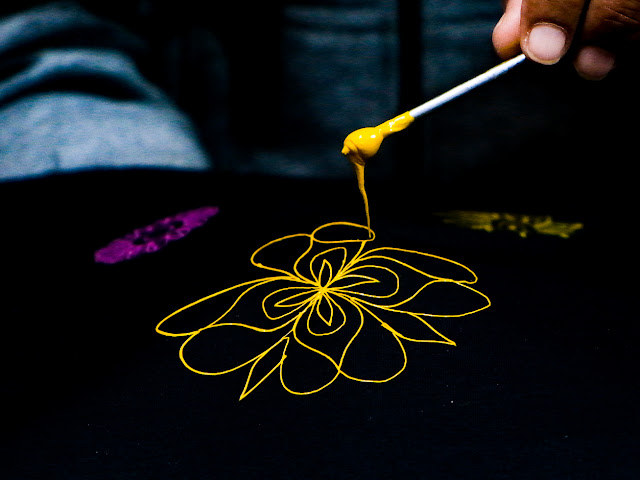


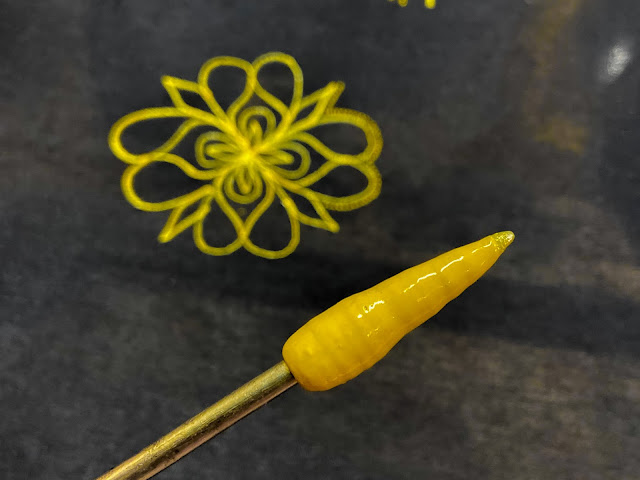
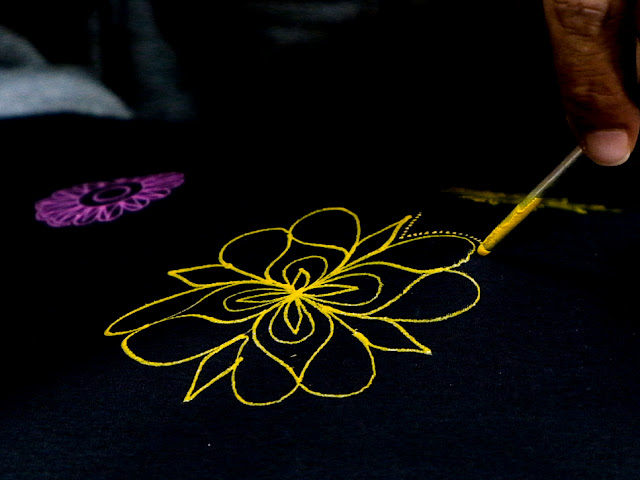



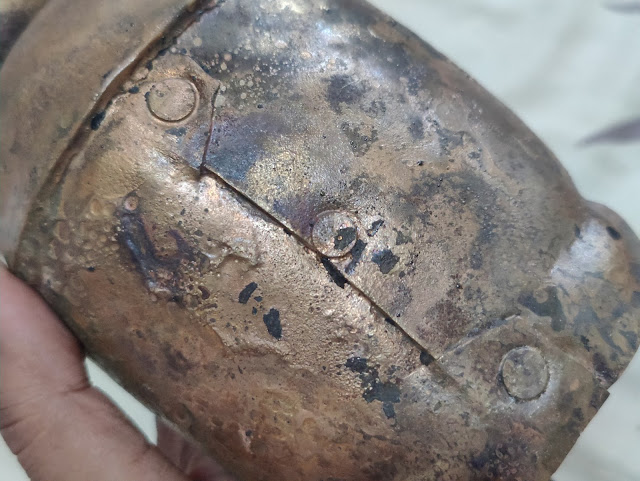




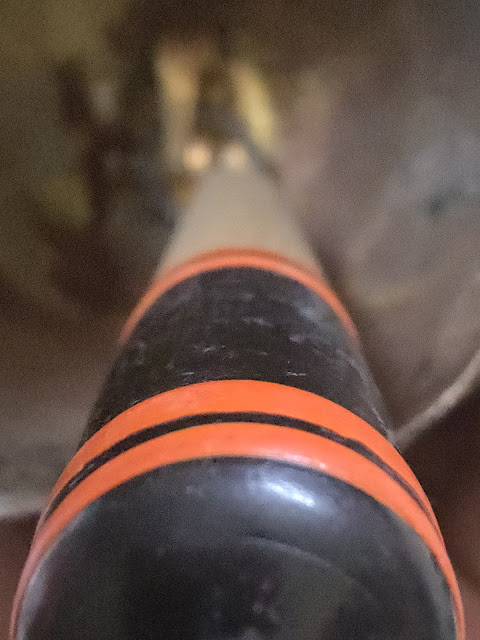
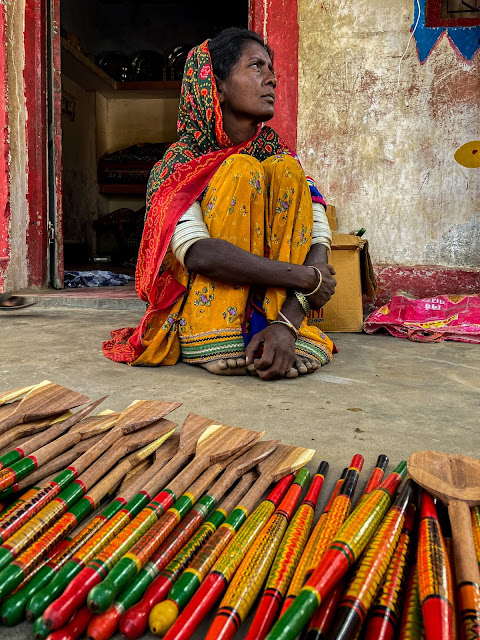
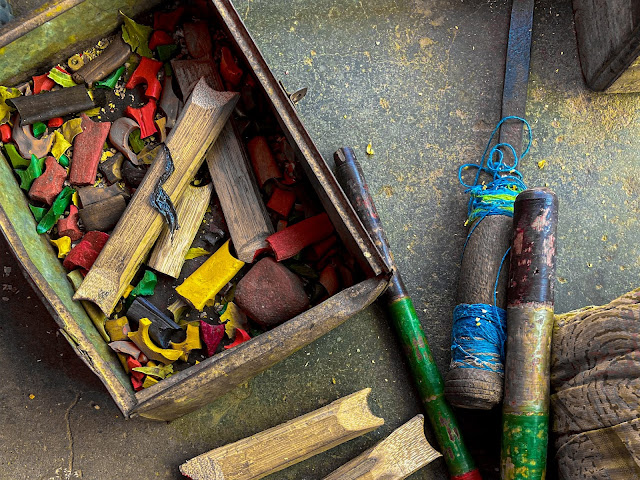
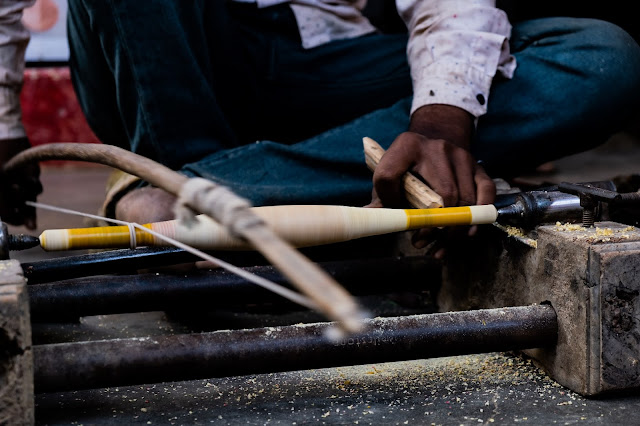

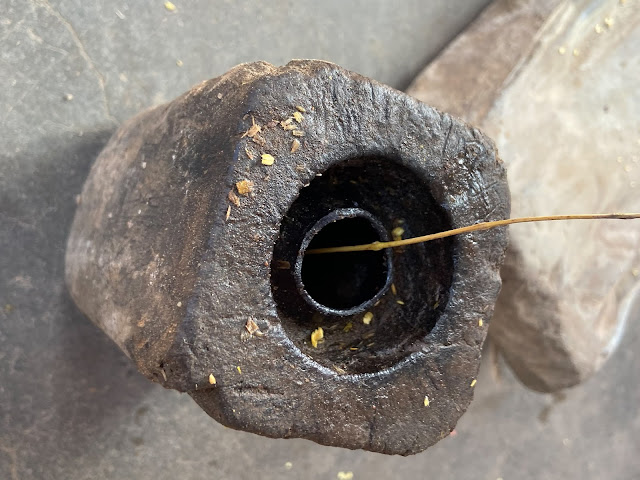


















Such a detailed post. Loved the art in Kutch, so colorful and intricate. Also you've got some amazing shots!
ReplyDeleteVery well researched article!
ReplyDelete